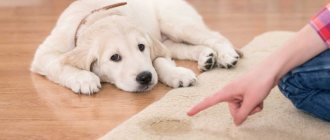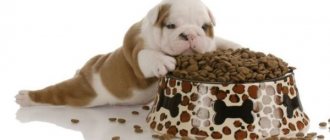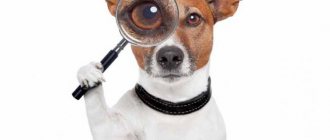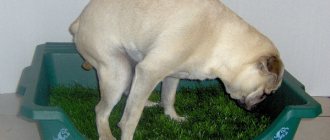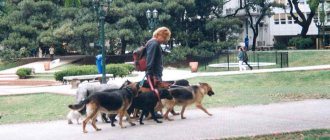How much water should a dog drink per day
Water is an important component of the dog’s body, which is responsible for the normal functioning of the vascular and digestive systems, the condition of the skin, fur and mucous membranes. During the hot season, the liquid is directly involved in the body’s thermoregulation processes, and with heavy loads on the joints, it has a positive effect by softening the connective tissue.
The well-being of an animal largely depends on the volume of water contained in its body. In turn, the optimal value can only be determined taking into account physical activity, weather conditions, type of feeding (dry or wet) and the size of the animal. On average, per 1 kg of dog weight there should be at least 50 ml of liquid per day. In summer, this value can increase to 70–80 ml, and in winter it can decrease to 20–30 ml.
Important! Huskies and Malamutes, as well as some other dog breeds, can consume additional moisture when eating snow in the winter. During this period, the amount of water drunk at home decreases significantly, but this should not alarm owners.
Natural reasons why a dog drinks a lot
- Season. In hot weather, your dog needs to replenish its fluid reserves to prevent dehydration and lower its body temperature to prevent overheating. On such days, it is recommended to take a bottle of cool water for a walk so that your pet can drink at any time.
- Nutrition. If a dog eats dry food, it will need to drink more often and more than dogs fed wet food. Dog owners also note increased thirst in their pet when switching from wet to dry food. This reaction is considered normal and should not cause concern.
- Low indoor humidity. In winter, heating and heaters start working, drying the air. People may not notice it, but dogs are sensitive to such changes. Dry air irritates the nose and respiratory tract, so the animal will strive to replenish the amount of fluid.
- Increased physical activity.
- Taking certain medications (for example, diuretics or anticonvulsants).
- Eating salty foods.
- Estrus. At this time, the dog drinks much more water than usual.
- Lactation period (feeding puppies).
- Age. In older dogs, kidneys often fail, the dog drinks a lot of water and urinates more often. Incontinence may develop. The animal needs to constantly replenish its moisture supply because of this.
In these cases, increased fluid intake is not dangerous for the dog. However, if this continues for more than a few days, it is worth taking the dog to the veterinarian: the reasons may be serious.
Why doesn't the dog drink water?
There may be several reasons why a dog does not want to drink water, and not all of them indicate the presence of pathology. To exclude the possibility of developing a disorder, it is worth carefully examining the animal and paying attention to the conditions of its detention. Perhaps the reason lies in poor water quality or high humidity in the room, although one should not exclude the possibility of injury to the oral cavity and diseases of the respiratory system, as will be indicated by additional signs.
Bad water
Many animals refuse to drink if food particles have fallen into it or if it has become heated by the sun's rays on a hot day. In addition, during the cleaning process, chemicals can get into the water bowl, giving it a repulsive odor.
If none of the above is typical for a particular case, perhaps the pet does not like the material of the vessel. Often, cheap plastic releases harmful substances into the water and this alarms the dog, not to mention the possible harm to its body.
Trauma to the oral cavity
Curling the tongue into a tube when consuming liquid is one of the physiological characteristics of the dog, allowing it to effectively direct water into the throat. With any injury to the gums, palate or tongue itself, it becomes painful for the animal to drink, which is also relevant for situations with the development of stomatitis. Additional symptoms indicating the presence of this unpleasant disease will be: a repulsive or even fetid odor from the pet’s mouth, tremors of the jaw muscles, excessive salivation, swelling of the mucous membranes of the mouth and enlarged lymph nodes. It is likely that the animal will begin to completely refuse not only water, but also food, or will eat very little. To effectively eliminate the problem, you will have to consult a veterinarian, but as first aid, you can irrigate the dog’s mouth with a two percent solution of table salt or baking soda.
If, during an examination of the animal’s oral cavity, bleeding and swelling of the gums were discovered, and they themselves became bright red in color, the dog most likely had to deal with manifestations of gingivitis (inflammation of the gums). Worsening the problem threatens the development of periodontitis, that is, the inflammatory process of the tissues surrounding the tooth itself. The gaps between adjacent incisors often increase and the teeth become pale, which also requires immediate contact with a veterinarian.
In case of mechanical damage to the tongue or any other part of the mouth, upon external examination it is easy to notice a scratch, especially since the affected area almost always looks slightly swollen.
Did you know? No two dog noses are alike. The pattern on their surface is as unique as human fingerprints.
Respiratory system diseases
Swelling of the larynx and difficulty swallowing water and food are also characteristic of diseases of the respiratory system. Thus, laryngitis or tracheitis can significantly complicate a pet’s life, leading to discomfort and pain during any attempts to drink or eat. Of course, in order not to experience unpleasant and even painful sensations, the pet will avoid contact with them.
During pregnancy
Late pregnancy in bitches is characterized by large abdominal volumes and the presence of a considerable amount of fluid in it. For this reason, in order not to “burden” themselves even more, some of them refuse to consume food and water. However, the expectant mother still needs to drink, since dehydration will not bring anything good to either herself or the puppies. If the dog refuses water altogether, it may have started to get sick and it is better to conduct additional examinations and consult a veterinarian, and in order to preserve the fluid reserves in the body, it would be wiser to switch the pet to a wet diet.
After operation
A dog may stop drinking due to surgery. Surgical intervention and the subsequent rehabilitation period take a lot of energy from the animal, so for several days after anesthesia it may well refuse food and drink. To prevent dehydration, you can gradually inject your pet with liquid from a syringe until he starts drinking, or use saline infusions, but only on the recommendation of a veterinarian.
Other reasons
In some cases, pets become capricious because of the very position of the container, when it is too low or high in relation to their height. Whether the bowl is fastened well or poorly in this case matters less, however, if it slides freely on the floor, this can also irritate the dog.
Among the diseases characterized by the lack of water consumption for a long time are problems with the dog’s kidneys, diabetes mellitus and malignant neoplasms. If a viral infection develops and body temperature rises, thirst increases, but there are situations when even in this state the dog may not want to drink.
Find out more about the reasons why dogs refuse food and water, and what needs to be done.
To prevent the water from stagnating, change it daily, each time thoroughly washing the bowl secured just below the dog’s chest. If the reason is in the vessel itself, try replacing it with denser plastic or a product made of a different material.
Why doesn't the puppy drink?
For a growing organism, water is no less important than for an adult dog. If the puppy eats well, but refuses to drink, perhaps he simply does not know how to lap or there is already enough liquid in the food. In the case where the cause of the disorder is pathology, most likely, we will be talking about the following possible options:
- entry of a foreign object into the animal’s body;
- food poisoning or intoxication of the body with chemicals;
- development of a viral or bacterial infection in the body;
- intestinal obstruction;
- disruption of the functioning of individual organs and systems of the body.
To confirm your guesses, first of all, try to bring your baby to a bowl of clean water and lightly poke his nose into the liquid. If he licks his lips and tries to take a few more sips on his own, it means that he will soon learn to drink on his own. If this does not happen, then you will have to use a bottle with a suitable nipple for some time.
If there is fever, chills, or swelling of certain parts of the body, the only correct decision will be a visit to the veterinary clinic and a more detailed examination of the animal. In this case, refusal of water can be considered as a concomitant symptom of a particular pathology.
Important! If a puppy drinks its mother's milk, it does not need water, since it gets everything it needs from it.
Additional rules for providing water for a decorative dog
- 1. Puppies should drink small amounts every two hours. After they drink, they should definitely be praised.
- 2. If, after intense play, the dog immediately drinks all the water in his search, do not pour a new portion immediately. Wait a little.
- 3. If you are planning a long walk with your dog with intense play, be sure to take water with you.
- 4. Monitor how much water your baby drinks especially closely on hot days.
Food to prevent the formation of tartar
How to treat constipation in a decorative dog?
Related Posts
How to tell if your dog is dehydrated
Prolonged refusal to drink or consumption of small amounts can very soon lead to dehydration of the dog and the gradual failure of certain organs. Externally, moisture deficiency in a pet’s body is determined in several main ways:
- Try to grab the skin at the dog's withers or shoulder blades and slightly pull it upward. Normally, the coat and layer of subcutaneous fat will quickly return, while with dehydration this happens very slowly.
- Check the condition of your pet's gums: in a healthy dog, they are always red-pink in color, and with light pressure they become white and immediately change their color to their usual color. If the surface always remains pale and dry, dehydration can be suspected.
Sometimes a lack of moisture in the body manifests itself in some symptoms of exhaustion, the most typical of which are the following:
- complete refusal to eat or loss of appetite;
- apathy and lethargy, with limited mobility of the animal;
- dullness of the eyes, with changes in the saturation of the iris;
- redness of the whites of the eyes.
The longer this condition of the dog persists, the greater the chance of developing serious, irreversible consequences in its body.
Did you know? A dog's saliva contains a large amount of the antibacterial substance lysozyme, the presence of which explains the wound-healing effect of the pet's tongue.
Reasons why the dog began to refuse food and water
There are many reasons why an animal may suddenly stop drinking and eating.
For example:
- diseases of the oral cavity, manifested by inflammatory processes that are accompanied by pain (laryngitis, stomatitis, mucosal injuries);
- pharyngeal spasms, a violation of the physiology of the swallowing process, are associated with a number of viral and autoimmune diseases;
- general diseases of the body (can get sick: kidney failure, diabetes, cancer), will not get up and not drink;
- dyspnea;
- overheating of the body, lethargy;
- diseases of the gastrointestinal tract (inflammatory processes, obstruction, diarrhea, constipation);
- parasitic infestations;
- poisoning of the body (severe intoxication);
- acute course of the disease associated with a high rise in body temperature, severe weakness of the body;
- obstruction of the esophagus caused by stuck foreign objects;
- small or advanced (old) age of the dog;
- dirty, musty water in a bowl, smelling unpleasant;
- inconvenient location of the bowl (high or low);
- poor quality of drinking and food utensils that emit unpleasant chemical odors, then he neither eats nor drinks anything.
If a dog does not drink enough or does not drink at all, then its body becomes dehydrated.
Please note that small dogs, particularly puppies, are more fragile and more susceptible to environmental influences.
The immunity of small dogs is weaker than that of adults and large dogs, and interruptions in health and well-being occur more often.
Lack of water and nutrients in the body has the most profound effect.
What are the dangers of refusing water for a dog?
Nutrients that enter the body along with food are dissolved in water and only after that are distributed through the tissues of the body along with the blood. If there is not enough fluid, the blood will thicken, and beneficial vitamins and minerals will not be able to reach the dog’s vital organs. In addition, without urination, waste and toxins accumulate in the body, which in turn suppresses the animal’s immune forces and interferes with the proper functioning of the kidneys. The pet becomes less active, the tone of its skin decreases, and the functioning of its joints worsens. Against the background of stagnation of toxins, intoxication often develops, which can be accompanied by vomiting and increased body temperature. All this creates favorable conditions for the development of chronic diseases, especially if the dog already has a tendency to them.
Prolonged refusal to drink leads to severe depletion of the dog’s body and, if the necessary measures are not taken in time, this can result in the death of the pet. The older and sicker the dog, the greater the likelihood of just such an outcome.
Why does a miniature dog drink little water?
If your toy dog is not drinking enough water in a day, even though you have given him the opportunity to do so, it is important to understand why this is happening.
Improper drinking behavior of an animal may be due to the presence of diseases such as pancreatitis, parvovirus infection, leptospirosis. If you suspect that your pet has these ailments, you should immediately run to the vet.
However, quite often dogs drink less water than they need, simply because they do not like to drink very much.
What to do if your dog doesn't want to drink water
For various reasons, a pet may refuse to drink water or reduce its consumption, so the owner should know in advance what to do in such cases. If the dog eats, drinks little, but generally remains active, you can adhere to the following action plan:
- organize regular physical activity for the animal, not forgetting to take a drink with you on walks;
- feed your pet only at the same time;
- leave the water in a place easily accessible to the dog, changing it daily;
- reduce stress factors as much as possible, in particular, do not scold the animal if it does not want to drink.
If you create all the conditions for the appearance of thirst, the pet itself should come to a bowl of water, and if this does not happen, the reason is deeper than it seems at first glance and it will no longer be possible to do without a complete diagnosis of the body.
Important! Normally, you should walk your dog every eight hours. When this is not possible, teach the animal to go to the litter box, since long-term restraint threatens to disrupt the functioning of the genitourinary system.
Four-legged aquatic
But when a dog drinks a lot of water, you also cannot remain indifferent. He drinks a lot and pees a lot, which puts increased stress on the kidneys. In addition, too much fluid in the tissues can cause edema, worsen the blood count, cause stomach upset and other problems.
Most serious illnesses provoke thirst, especially at the initial stage. If your dog frequently drinks water, one and a half to two times more than usual, the first step is to measure the temperature. Of course, as mentioned above, if thirst is not associated with heat or mobility. Almost all viruses increase thirst: when the immune system is activated, a large amount of moisture is lost.
Close attention should be paid to the condition of the liver and kidneys, especially if the old dog drinks a lot and goes to the toilet frequently. These same symptoms may indicate the onset of diabetes, and in bitches – endometritis and pyometra. Sometimes thirst is provoked by tumor diseases.
You should not limit fluid intake until your veterinarian finds out exactly why your dog is drinking a lot of water. Exceptions are vomiting after drinking and swelling. But in these cases, you need to go to the clinic immediately, and the veterinarian, after examining the pet, will decide in which direction to move.
Of course, you shouldn't panic right away. Thirst can be caused by the most harmless reasons. For example, a child gave a dog candy secretly from his parents. Single attacks of thirst or refusal of water for several hours are not a reason to be alarmed (if everything else is fine). But if the situation repeats or drags on for several days, be sure to find out from the doctor why the dog does not drink water or, on the contrary, drinks a lot. As a rule, inspection is not enough. You will need to take blood and urine biochemistry and perform an ultrasound of the abdominal cavity.
If the dog does not receive enough fluid, this leads to dehydration, which, in turn, has an extremely negative impact on the pet’s health.
The first thing you notice when dehydrated is a deterioration or complete loss of appetite, lethargy, lack of activity, and sunken eyes. If these symptoms have already appeared, then you should definitely seek help from a veterinary clinic.
Every day the dog must drink a certain amount of water, which can be calculated using a special formula.
To calculate how much water a dog should drink every day, use the following formula: 20−70 ml for every kg of pet’s weight. If your four-legged friend weighs, for example, 10 kg, then his daily water intake is 0.2−0.7 liters.
This figure may be influenced by various factors. So, in winter the animal drinks less than in summer. He needs more moisture after active walks. However, the amount of water may decrease if the pet receives a lot of wet food during the day.
Diagnosis and treatment of possible diseases
Prolonged refusal of water leads to dehydration. Prolonged dehydration has a detrimental effect on the functioning of the entire body, starting with the smallest structural units. The processes of food digestion and blood circulation are not possible without the proper amount of fluid intake. Thanks to water, metabolic products, toxic substances, are eliminated from the body. Water allows for normal heat exchange.
The amount of water for an animal is calculated using the formula - 20 ml per 1 kg of animal weight. Values may differ with heavy physical activity, age-related changes, and dietary habits. In the hot season, the dog consumes much more water than in the cold season.
In a veterinary clinic, a specialist will conduct a general clinical examination of the patient, collect anamnesis, and, if necessary, prescribe a number of laboratory tests. The degree of dehydration of the body is determined by physical methods. The skin in the nape area is pulled back with two fingers and released. If the skin returns to its original value quickly, this indicates a lack of dehydration. The slow return of the pulled fold of skin to its place indicates pathological changes.
Based on the data obtained, the doctor develops treatment tactics. In some cases, the specialist gives the following recommendations:
- Give the animal more physical activity. A dog's need for water decreases when it stays in an apartment for a long time. Toxins accumulate and are slowly eliminated.
- Give food in doses, without leaving the bowl of food freely available after eating. This will allow the animal not to confuse thirst with hunger.
- Tracking the frequency of trips to the toilet. Rare walks and, accordingly, infrequent opportunities to relieve themselves, provoke the accumulation of urine in the body and the lack of need to drink more fluid.
- Drinking water must meet the requirements. It is recommended to change the water in the bowl more often, especially in hot weather.
If the reason for refusing water is an infectious disease, appropriate treatment is prescribed. Bacterial infections are treated with antibiotics, probiotics and immunomodulatory drugs are prescribed. An obligatory point of treatment is to increase the body's resistance - the introduction of vitamin and mineral complexes into the diet.
What kind of water can you give your dog?
The ideal option is running water, which, if left in the bowl for a long time, should be renewed periodically. It is important to wash your water bowl every day, even if it looks clean.
Ordinary tap water is quite suitable, if it is not of absolutely terrible quality, it’s good if the water is filtered.
If your tap water is so terrible that you yourself do not risk cooking food with it, it is also better not to give it to your dog, or to boil it first. We are talking about the worst quality, since many people now do not cook with tap water, even if it is acceptable. In other cases, there is no need to boil water for the dog.
If your tap water has a lot of chlorine, let it sit before giving your dog water.
Some people give their dogs mineral water. This approach is justified only if there is nothing else at hand and the dog is thirsty. There is no other reason to give your pet mineral water, and carbonated water is not acceptable for a dog. If, for example, on the road, it happens that there is nothing but carbonated mineral water, shake and open the bottle so that the maximum amount of gases comes out.


